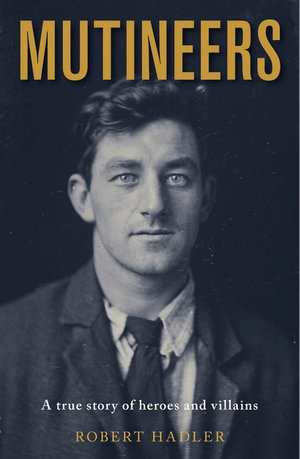
Mutineers – A true story of heroes and villains. By Robert Hadler. Wilkinson Publishing, Melbourne, 2021.
Reviewed by Greg Swinden
The word Mutiny will always catch the eye of a prospective reader and Robert Hadler has chosen another under-reported aspect of the Royal Australian Navy’s history for his most recent book.
Previous analysis of the 1919 HMAS Australia mutiny, in Fremantle, has been sparse with the matter quietly omitted from the RAN’s official history for World War I (published in 1928) and only a few articles in more recent times; Robert Hyslop’s 1970 article in the Australian Journal of Public Administration and Graham Wilson’s article in the Journal of the Australian Naval Institute in 1996). Both articles, however, left many questions unanswered.
Now for the first time much of the full story is told although it will be up to the reader to ascertain who the heroes and villains might be in this saga. So what was the Australia mutiny? On 28 May 1919 the battlecruiser Australia arrived in Fremantle – her first Australian port after the ship had been absent on war service since late 1914. About half her ship’s company had served onboard throughout those four long years of war including the book’s hero (or villain) Able Seaman Dalmorton Rudd. When the ship was due to leave Fremantle, on 1 June, a large group of sailors put forward an unprecedented request to their commanding officer to allow the ship to stay in port. When Captain Cumberlege denied this unusual request a smaller group of masked men, led by Dalmorton Rudd and his younger brother Stoker Leonard Rudd, entered the boiler room and convinced the stokers on watch to abandon their post; thus stopping the ship from initially leaving port.
After Australia was able to sail several men, including the Rudd brothers, were arrested and charged with mutiny; not including violence. The ‘mutiny’ could have been dealt with onboard; even the commanding officer calling it more of a ‘strike’. It soon however saw a court martial imposed with five men standing trial (there was a sixth mutineer but he somehow slipped ashore when the ship was in Melbourne and deserted). The five other men including Dalmorton Rudd and his younger brother were sentenced to various terms of imprisonment at Goulburn Gaol and dismissal from the service. End of story – well not quite!
Many Australians saw the gaol terms as excessive ‘Royal Navy’ discipline imposed on the young Australian sailors. Soon the Labor Party seized upon the issue and with a federal election pending, and with Prime Minister Billy Hughes still absent overseas at the peace talks at Versailles, the matter became a political football as the Labor Party stridently called for the convicted men to be released from Goulburn Gaol. Eventually, in December 1919, the five men were released as part of a Peace Amnesty – but only after British consent was given!
This in turn created a crisis between the RAN leadership and the politicians. The two senior officers, the 1st Naval Member (Rear Admiral Grant) and the Fleet Commander (Commodore Dumaresq) were loan officers from the Royal Navy and they did not believe they had been properly consulted. Both men wrote directly to the Prime Minister threatening to resign. This later incident was played out behind the scenes and well out of public and media view but the Governor General, Sir Ronald Munro Ferguson also became involved with secret updates to the British Government which the Australian politicians were not aware of.
Eventually in early 1920 the crisis was resolved and the whole matter slipped into obscurity; but if there was ever a story worthy of a TV mini-series than this is it.
Much of the book focuses on Dalmorton Rudd – a complex character and a natural leader. He was awarded a Distinguished Service Medal for bravery for his part in the raid on the German held port of Zeebrugge in April 1918 which saw bitter hand to hand fighting and heavy casualties amongst the raiding party. Rudd married an English girl in early 1919 – but his wife died soon after from pneumonic influenza. His character began to change and he began to drink more heavily. Today this would be recognised at Post Traumatic Stress Disorder and this may have contributed to his actions on that fateful day in Fremantle.
Mutineers is highly recommended. Hadler’s book is well written, extensively researched and easy to read but I will leave the reader to make an assessment of who the heroes and villains are. That said, in my opinion as a naval officer, if this event occurred in an Australian warship today the perpetrators would be facing a court martial and, if found guilty, would most likely be sentenced to a period of detention in the Defence Force Corrective Establishment and their naval service terminated.



